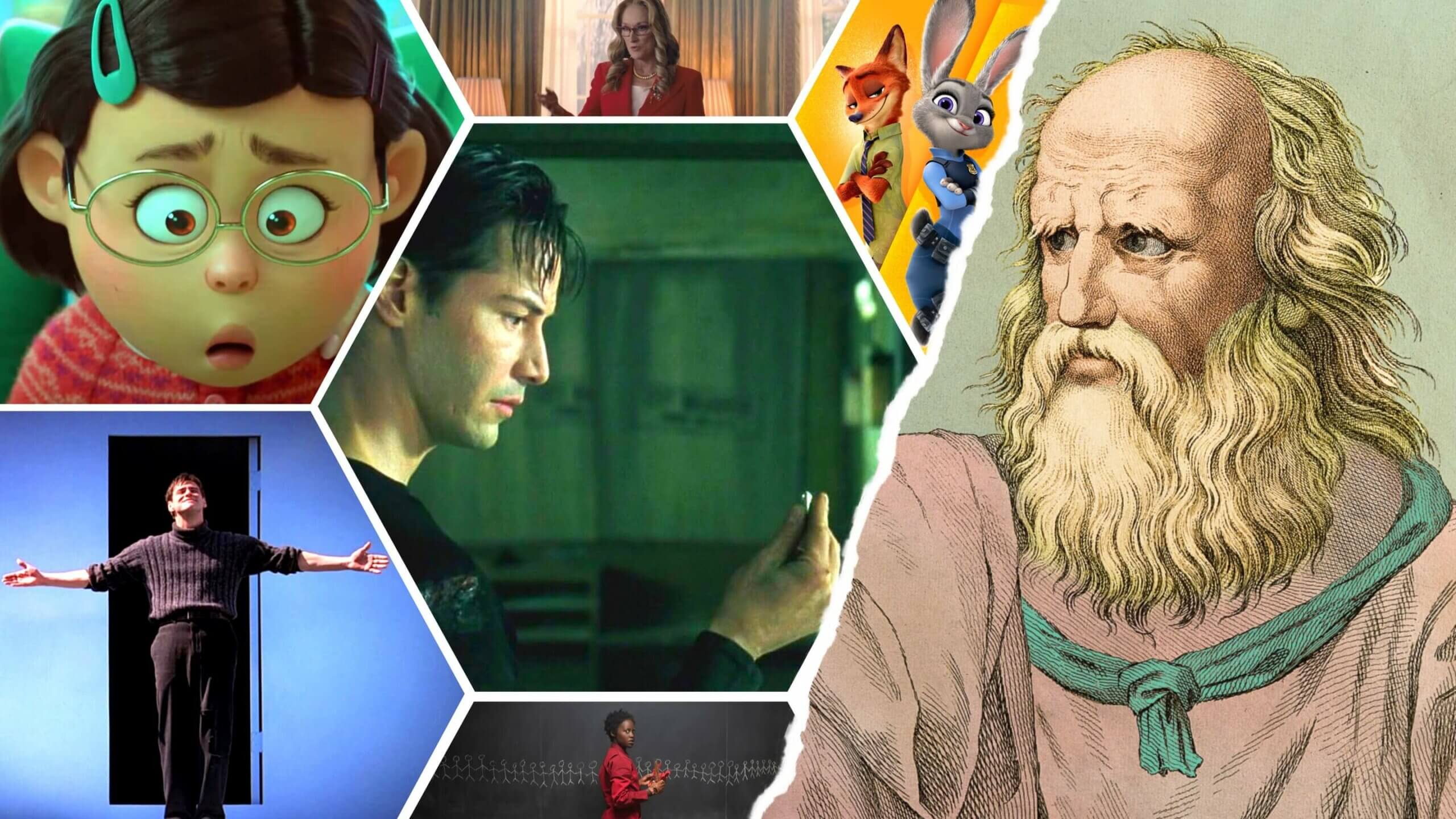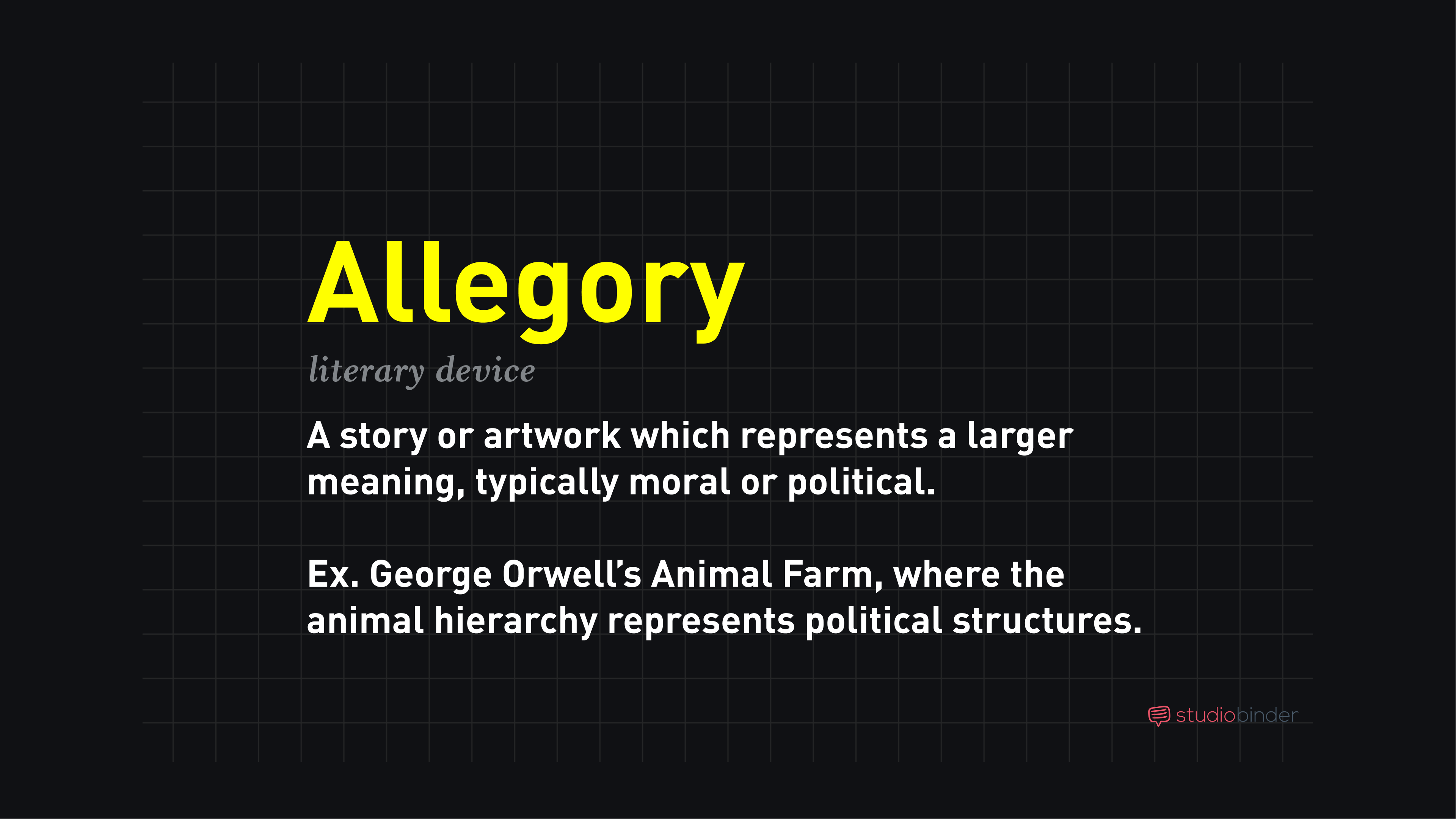What is an allegory? An allegory is an important part of a symbolic story. Many of us have heard the term used when describing literature or film, but how do we know what it means? We’re going to get to the bottom of those questions by looking at famous examples. But first, let’s define allegory through exploring its etymology.
What Does Allegory Mean?
How to Define Allegory
Allegories are used in storytelling to communicate something symbolic; whether it be moralistic or political.
Some allegory examples in literature include the self-titled Animal Farm allegory, the setting of Metamorphosis, and the social order in 1984.
We’re going to focus on how allegories are used in cinema and literature. But before we jump into our examples let’s start with an allegory definition.
ALLEGORY DEFINITION
What is an allegory?
An allegory is a storytelling technique used to convey something symbolic to the audience. Unlike metaphors, which serve to symbolize something on a one-to-one basis, allegories are used in a more grand sense. A whole story can be an allegory, and be made up of many metaphors.
Characteristics of an Allegory:
- Contains beginning and end
- Has a message or moral
- Adds to a theme of the story
Download Allegory Definition and Examples image for your reference
What is an Allegory and Where did it Originate?
Allegory Examples in Movies & Literature
Now that we’ve reviewed the allegory definition, let’s take a look at some allegory examples in movies and literature.
ALLEGORY EXAMPLES IN MOVIES
- Avatar – an allegory for imperialist oppression; and how it destroys indigenous cultures and the environment.
- Metropolis – an allegory for class warfare; and the worsening divide created by industrialism.
- The Truman Show – an allegory for reality TV obsession; and how real people are dehumanized by consumer audiences.
- La Strada – an allegory for the road of life; and how in the end, we’re all swept back to the seashore.
- The Seventh Seal – an allegory for religious judgement; and the eternal battle between life and death.
- Fight Club – an allegory for consumerism; and how social expectations corrupt our sense of self.
ALLEGORY EXAMPLES IN LITERATURE
Note: some of the most famous “allegory in literature” examples are technically fables because they include anthropomorphized animals. That being said, the actionable difference in the allegory novel definition is minute; so we’re going to include the Animal Farm allegory and other examples here.
- Animal Farm – a fable/allegory for revolution; and how the pursuit of power is often feigned for idealism.
- The Lorax – a fable/allegory for deforestation; or the destruction of ecology for financial profit.
- The Trial – an allegory for bureaucracy; and how “the system” keeps “the man” down.
- The Crucible – an allegory for persecution; and how groups with power seek to disarm groups without power.
- Lord of the Flies allegory for social structure; and how humans conceal their savage ways.
- The Lion, the Witch and the Wardrobe – a religious allegory for the betrayal of Christ.
What is an Allegory Used For?
Allegory vs Other Devices
Allegories can sometimes be confused for other literary devices as well. Let’s take a look at how an allegory differs from some of the following terms.
Allegory vs metaphor
There is some overlap between allegories and metaphors. Allegories are figuratively symbolic of another idea, while metaphors also utilize a figurative comparison.
But metaphors are much more one-to-one than allegories. Take the metaphor “The headline was a slap to the face.” The comparison here is clear: the headline is like a slap to the face.
With allegories, however, things can be much more open ended, and are less comparative.
Allegory vs parable
A parable can be considered a subtype of an allegory. Parables are short, simple stories that have larger moral lessons that are relatively easy to identify. Take “The Boy Who Cried Wolf” for example. Everyone knows the beats of that short story, and everyone knows the lesson.
Thus, a parable is an allegory, but not all allegories are parables. Many allegories, like most of the ones we’ve already mentioned, are far too complex and nuanced to be considered parables.
Allegory vs fable
Fables are very similar to parables. The main difference is that fables focus on non-human characters, so they are more fantastical in their nature. “The Tortoise and the Hare” is a famous example of a fable.
As such, fables too are a subtype of the allegory.
Allegory vs symbolism
Symbolism refers to an object or event which has a larger, typically figurative significance. Therefore, allegories are rife with symbolism.
Take Avatar. The Na’vi are symbols for indigenous people, while unobtainium is a symbol for whatever resource the market demands (oil, gold, etc.). Taken as a whole, the narrative is an allegory.
Now, let’s dig in a little deeper to the subtypes of allegories we’ve already mentioned.
What is an Allegory Used For?
Breaking Down Other Types of Allegory Examples
As we alluded to earlier, both fables and parables have been used for centuries to convey metaphors in storytelling. Although these types of allegories are more prevalent in literature, they’re still sometimes used in film.
Classical allegory
Classical allegories refer more to the time in which they were written than their subject matter. These types of allegories originated in ancient Greece and Rome. Arguably the most famous classical allegory is Plato’s Allegory of the Cave, which tackles nothing less than how we perceive our world.
Biblical allegory
There are two tiers of biblical allegories. One tier refers to allegories which are in the Bible– and there are a lot.
The other tier are allegories which have biblical themes. Take The Chronicles of Narnia, which uses the Lion, Aslan, as a Christ-like figure. If you haven’t noticed, the Bible is a pretty popular book, so there are tons of biblical allegories throughout art.
Modern allegory
Not all allegories are from Ancient Greece or the Bible. Modern allegories are allegories which comment on our current zeitgeist. Sometimes, these allegories can be accidental. In other words, an author is so influenced by the world around them that they inadvertently comment on that world in their writing. This is called “allegoresis,” where it’s not clear if an allegory was created on purpose.
This famously happened with J.R.R. Tolkien, whose Lord of the Rings can be seen as an allegory for World War I, even though he never explicitly stated that that was his goal.
Allegory Meaning
How to Write an Allegory
One film that’s chock-full of symbolic metaphors is Fight Club. From beginning to end, we see symbols that address issues of individualism, collectivism, consumerism, masochism, and all sorts of other -isms. An allegory is used to bind these -isms together.
We imported the Fight Club screenplay into StudioBinder’s screenwriting software to take a look at how writer Jim Uhls uses dialogue to communicate these issues. As you’re reading, think about how dialogue is used to speak to a greater symbolic point.
What’s an Allegory? • Fight Club Screenplay
Fight Club is very much about the destruction of consumerism, epitomized by violent acts committed against the wealthy. It’s also about an idealization of collectivism. The Narrator is a character who feels isolated, excluded, and out of favor with society.
That is until he starts “fight club” and finds the fraternity he was so desperately looking for. But when “fight club” is contorted to Project Mayhem, he reverts back to his primal, outsider tendencies.
Tips on Writing an Allegory
Tips on How to Write an Allegory
So how can you write an allegory as successful as Fight Club. Well, there are no guarantees, but here are a few steps you can take:
- Decide what you want your story to represent. Fight Club is about consumerism, Avatar is about colonialism. What do you want to tackle with your piece?
- Elevate the reality. Allegories typically exaggerate what they represent to highlight its core truths. Take what you are creating an allegory for and exacerbate it.
- Design your story. Now that you’ve decided on your world and how it’s heightened, it’s time to create your story within it.
- Focus on your theme. As you’re writing, remember to keep your key themes front of mind, so that the allegory continues to carry from beginning to end.
Allegories are an incisive way to examine our world. They’re not easy to pull off, but if you do, you can make people think differently about what they’ve taken for granted.
UP NEXT
Explore more literary devices
An allegory is just one of many literary devices and types of figurative language, including irony, satire, and paradox. If you're a writer and want to develop your craft fully, do yourself a favor and continue this exploration. The next article on literary devices is a gateway to many of these tools that help add substance and style to any type of written work.


